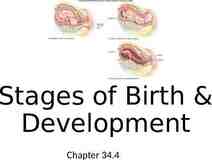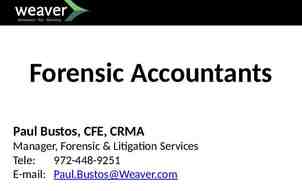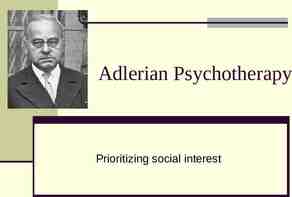The SBA All Small Mentor Protégé program and changes to the
23 Slides143.60 KB

The SBA All Small Mentor Protégé program and changes to the Limitations on Subcontracting regulations Douglas Gerard Procurement Center Representative for Alabama and Georgia Small Business Administration Government Contracting Area III

The SBA All Small Mentor-Protégé Program New program regulated under 13 CFR §125.9 Patterned on existing 8(a) Mentor-Protégé program Designed as a business development tool Provide financial, technical, and/or management assistance Allows ALL small business protégés to joint venture with their large business mentors Mentor can own up to 40% of the protégé Exception to affiliation

Benefits Mentor-protégé joint ventures may qualify as a small business for any federal government contract or subcontract where the protégé qualifies as small for the size standard assigned to the procurement Protégé firm shielded from a finding of affiliation where a large business mentor owns no more than 40% of protégé Once mentor-protégé relationship ends, any protection from affiliation also ends Agencies may provide incentives in contract evaluation process to a firm that will provide significant subcontracting work to its SBAapproved protégé

Benefits for Contracting Offices Larger set asides Easier to meet SB goals for the organization The mentor’s qualifications are added to that of the small business reducing risk. Less chance of a size protest: So long as the ASMPP office has approved the MP, the affiliation between the two companies is negated. Smaller number of proposals received: the number of approved MPs is less than the number of large and small businesses

Benefits for Small Businesses No cost training Opportunity to participate in larger, more complex contracts Funding: up to 40% of the total ownership equity can be purchased by the mentor firm under mutually agreeable terms between the MP partners. New relationships: working with a JV partner can lead to a preferred subcontractor in future work. Protection from affiliation concerns (for the MP partner only)

How to apply Newly created unit within Office of Business Development Final decision making authority vested in the SBA AA/BD Due to application volume/oversight, SBA may institute open enrollment periods in the future 8(a) mentor-program remains separate and distinct Office of Business Development will continue processing 8(a) and small business mentor-protégé applications separately 8(a) firms can apply to either office

How to Apply Prospective applicants must register in the System for Award Management (SAM) prior to submitting their All Small MentorProtégé Program (ASMPP) application. Additionally, both prospective Protégés and Mentors are required to complete an online training module as part of the application process. Please note that a Mentor-Protégé relationship should be established before starting this application – the ASMPP is not a matching program.

How to Apply Only applications submitted through certify.sba.gov will be considered. If you applied to the ASMPP prior to November 1, you will be instructed to finalize the administrative process by adding your profile to certify.sba.gov, and uploading your application and documents into that repository. Please note that both you and your Mentor will need to complete the online training module in order to establish your profile in certify.sba.gov. A Sample ASMP Agreement template is included at the end of this presentation

Applications Applications will only be accepted electronically using new online application available at certify.sba.gov All documents (e.g., signed MPAs) to be uploaded to certify.sba.gov SBA retains right to request financial statements and tax returns during reporting and evaluating process Applicants required to register in SAM PRIOR to creating profile in certify.sba.gov Applicants (both mentors and protégés) required to complete online training module and upload certificate of completion to certify.sba.gov BEFORE completion of application process

Protégé eligibility Must be small under its primary NAICS code OR seeking assistance in secondary NAICS code under which it is small May self-certify that it qualifies as small for its primary or secondary NAICS code For secondary NAICS code approval, must demonstrate prior experience and logical business progression Will approve a 2nd mentor only if: 2nd relationship pertains to unrelated NAICS code AND Protégé seeks to acquire specific expertise first mentor does not possess SBA may examine protégé’s SDVOSB or WOSB self-certification as part of application process

Mentor eligibility Must demonstrate capability of fulfilling obligations under mentor-protégé agreement May submit copies of federal tax returns, audited financial statements or, if publicly traded, SEC filings Possess good character Not suspended or debarred Impart value due to lessons learned and practical experience Only for-profit firms for both 8(a) and new MP programs Can be any size Generally, no more than one protégé at a time Limit of three protégés at one time if there is no adverse impact on any protégé Protégés may concurrently serve as a mentor

Written MP Agreement Agreement must set forth assessment of protégé’s needs Detailed description and timeline for the delivery of the assistance by the mentor which will enable protégé to meet its goals Minimum one year commitment Single point of contact for mentor responsible for managing and implementing the MPA Identify any other mentor-protégé relationship held by the protégé (either SBA or Agency) Written agreement approved by AA/BD Changes must be approved by the SBA Either party may terminate with 30 days advance notice Reviewed annually by SBA –SBA may terminate at any time Must follow the ASMPP template, NOT the 8(a) template

MP participation period Up to three years in one agreement, maximum of six years overall Protégé may have two three-year MPAs with different mentors EACH may be extended an additional three years 8(a) approved mentor-protégé relationships may transfer to the new mentor-protégé program after graduating from the 8(a) program 8(a) participants in last six months of their programs terms may apply for an 8(a) mentor-protégé relationship, as it could carry over to new small business mentor-protégé program

Declined applications If SBA declines application, protégé may file request for reconsideration within 45 days Able to revise MPA during reconsideration to provide additional information and documentation SBA to issue reconsideration decision within 45 days –if declined again but for different reasons, protégé can submit new reconsideration request If application is declined, proposed protégé cannot attempt to enter into another mentor-protégé relationship with the same mentor for a 60 day period Can submit application with new mentor at any time

Lessons learned Make sure that both the potential protégé and mentor have completed the online tutorial and have their certificates saved before beginning the application process online Use the Mentor-Protégé Agreement (MPA) for the All Small Mentor Protégé Program (ASMPP), which is located on the SBA website and provided in this training DO NOT USE the 8(a) Mentor-Protégé template-submissions using that template will be require resubmission with the ASMPP template based application.

6 months into the program Of the total submissions the SBA has received, 161 ASMPP applications have been approved as of 5/5/17 and 26 have been declined The main reason for declines is when a firm does not provide requested additional information/corrections in the time requested or failure to meet the program eligibility requirements. There will be a list of approved ASMPP relationships on the SBA ASMPP webpage shortly – please check that website for updates Questions regarding the ASMPP should be emailed to [email protected]

Similarly situated entities 13 CFR § 125.6 (c) Subcontracts to similarly situated entities. A small business concern prime contractor that receives a contract listed in paragraph (a) of this section and spends contract amounts on a subcontractor that is a similarly situated entity shall not consider those subcontracted amounts as subcontracted for purposes of determining whether the small business concern prime contractor has violated paragraph (a) of this section, to the extent the subcontractor performs the work with its own employees. Any work that the similarly situated subcontractor does not perform with its own employees shall be considered subcontracted SBA will also exclude a subcontract to a similarly situated entity from consideration under the ostensible subcontractor rule (§ 121.103(h)(4)).

Similarly situated entities: Example 1 Example 1 to paragraph (c): An SDVO SBC sole source contract is awarded in the total amount of 500,000 for hammers. The prime contractor is a manufacturer and subcontracts 51% of the total amount received, less the cost of materials ( 100,000) or 204,000, to an SDVO SBC subcontractor that manufactures the hammers in the U.S. The prime contractor does not violate the limitation on subcontracting requirement because the amount subcontracted to a similarly situated entity (less the cost of materials) is excluded from the limitation on subcontracting calculation.

Similarly situated entities: Example 2 Example 2 to paragraph (c): A competitive 8(a) BD contract is awarded in the total amount of 10,000,000 for janitorial services. The prime contractor subcontracts 8,000,000 of the janitorial services to another 8(a) BD certified firm. The prime contractor does not violate the limitation on subcontracting for services because the amount subcontracted to a similarly situated entity is excluded from the limitation on subcontracting.

Similarly situated entities: Example 3 Example 3 to paragraph (c): A WOSB set-aside contract is awarded in the total amount of 1,000,000 for landscaping services. The prime contractor subcontracts 500,001 to an SDVO SBC subcontractor that is not also a WOSB under the WOSB program. The prime contractor is in violation of the limitation on subcontracting requirement because it has subcontracted more than 50% of the contract amount to an SDVO SBC subcontractor, which is not considered similarly situated to a WOSB prime contractor.

Similarly situated entities: Exemptions 13 CFR § 125.6 (f) Inapplicability of limitations on subcontracting. The limitations on subcontracting do not apply to: (1) Small business set-aside contracts with a value greater than 3,500 but not 150,000, or (2) Subcontracts (except where a prime is relying on a similarly situated entity to meet the applicable limitations on subcontracting).

Similarly situated entities: Penalties 13 CFR § 125.6 (h) Penalties. Whoever violates the requirements set forth in paragraph (a) of this section shall be subject to the penalties prescribed in 15 U.S.C. 645(d), except that the fine shall be treated as the greater of 500,000 or the dollar amount spent, in excess of permitted levels, by the entity on subcontractors. A party's failure to comply with the spirit and intent of a subcontract with a similarly situated entity may be considered a basis for debarment on the grounds, including but not limited to, that the parties have violated the terms of a Government contract or subcontract pursuant to FAR 9.406-2(b)(1)(i) (48 CFR 9.406-2(b)(1)(i)).

Questions?






